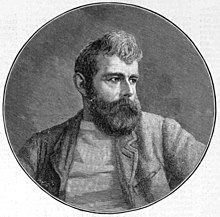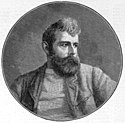William Lionel Wyllie

William Lionel Wyllie RA (* 5. Juli 1851 in London; † 6. April 1931 ebenda) war ein britischer Marinemaler.[1]
Leben
Wyllie war der ältere Sohn des Malers William Morison Wyllie und Bruder von Charles William Wyllie, der ebenfalls Maler wurde. Sein Halbbruder war Lionel Smythe[2], der ebenfalls ein angesehener Maler war. Er durchlief 1865 die geforderte Grundausbildung an der Heatherley School[3] und studierte von 1866–9 an der Royal Academy in London unter so bekannten Größen wie Frederic Leighton, John Everett Millais, Edwin Landseer und anderen Malern der viktorianischen Zeit. 1869 wurde er mit der Turner-Medaille für das beste Landschaftsbild "Dawn after a Storm" ausgezeichnet.
1899 wurde er in die Royal Academy aufgenommen und stellte seine Werke The Phantom Ship und Davy Jones' Locker aus. Er schuf zahlreiche Aquarelle, Ölgemälde, Kupferstiche und Radierungen. Im Ersten Weltkrieg diente er als Kriegsberichterstatter. Aus dieser Zeit stammt sein 1917 entstandenes Gemälde Iron Duke Opening Fire, das heute im Besitz von Nick Jellicoe ist.
Werke
- sein wichtigstes Werk ist das Panoramabild Die Schlacht von Trafalgar mit einer Größe von 13,5 × 3,6 Meter, an dem er 20 Jahre lang arbeitete.
- The Phantom Ship stellt das Geisterschiff aus dem gleichnamigen Roman von Frederick Marryat dar, der Vorlage für die Oper Der Fliegende Holländer von Richard Wagner.
- Davy Jones’ Locker spielt auf eine Legende um einen untoten Piraten an.
- Radierung von Veere
- The Track of Lusitania.
- Die Teutonic verlässt Liverpool
- HMS Valorous
- Der Zerstörer Derwent torpediert den Kreuzer Aeolus am 27. August 1904
- Das Öffnen der Tower Bridge, 1895
- HMS Calypso, 1897
- Battle of the Nile 1899
Veröffentlichungen
- J.M.W. Turner. Publisher: George Bell & Sons, London 1905
- ; mit seiner Ehefrau
- Beautiful Britain. London to the Nore. Painted by W. L. Wyllie and described by Marion Amy Willie. Publisher: A. C. Black, London 1905
- Marion Amy Willie: Norway and its fjords. With 16 illustrations by W. L. Wyllie. Publisher: Menthuen & Co., London 1907
- ; als Kriegsberichterstatter
- William L. Wyllie, M. F. Wren: Sea Fights of the Great War: Naval Incidents During the First Five Months. Publisher: Cassell & Co., London 1918
- William L. Wyllie, M. F. Wren: Sea fights of the great war (microform): naval incidents during the first nine months Publisher: Cassell & Co., London 1918
- W.L. Willie, Charles Owen, W.D. Kirkpatrick: More sea fights of the great war, including the battle of Jütland. Publisher: Cassell and Company, London 1919
Einzelnachweise
- ↑ PM History, November 2006, Seite 60f.
- ↑ Lionel Smythe R. A.
- ↑ Heatherley’s School ( vom 9. September 2010 im Internet Archive)
Weblinks
- Royal Naval Museum in Portsmouth zu Wyllie
- Bilder Wyllies ( vom 6. April 2013 im Internet Archive)
- William Lionel Wyllie – The Royal Museums in Greenwich
- Willie at the Tate Gallery
- “The Pool of London” at Christie’s auction
- Bilder von W. L. Wyllie in Auktionen
| Personendaten | |
|---|---|
| NAME | Wyllie, William Lionel |
| KURZBESCHREIBUNG | englischer Marinemaler |
| GEBURTSDATUM | 5. Juli 1851 |
| GEBURTSORT | London |
| STERBEDATUM | 6. April 1931 |
| STERBEORT | London |
Auf dieser Seite verwendete Medien
A clever feat: the destroyer HMS Derwent torpedoing the Apollo class cruiser HMS Aeolus during the manoevres 27 August 1904 or Destroyer Derwent at torpedo practice by W L Wyllie
HMS Valorous cropped from Sketches of HMS Discovery, Valerous (sic) and a sailing vessel
The track of Lusitania. View of casualties and survivors in the water and in lifeboats.
An engraved portrait of British artist William Lionel Wyllie
Mr WL Wyllie. Illustration for The Illustrated London News, 4 May 1889.
Read the ILNEtching of the Dutch town of Veere.
The 'Teutonic' leaving Liverpool, by William Lionel Wyllie.
A portrait of the White Star liner, RMS Teutonic, leaving Liverpool in July 1889. The ship was built in 1889 for the Atlantic trade by Harland & Wolff Ltd in Belfast, for Ismay Imrie & Co. of Liverpool, the White Star owners. When launched, Teutonic caused a sensation because she and her sister ship, RMS Majestic (1890), were the first luxury liners to be specially designed for potential use as armed merchant cruisers, with gun mountings, magazines and additional bunkerage. She is shown here as a brand new ship in port-bow view, sailing for the Spithead review held in honour of Kaiser Wilhelm II of Germany on 4 August 1889. Teutonic is also shown flying the blue ensign from the stern (the colour of the Royal Naval reserve and auxiliary forces) and the White Star flag (a white star on a red ground). She has two funnels painted yellow and set far enough apart to enable the saloon to be placed in between. She is flanked by two attendant tugs and the city of Liverpool is visible behind her in the left distance.
Sails of sailing ships, representing another age, are shown amongst the funnels and seagulls are featured on the water. The artist and his wife were among the White Star guests who sailed on Teutonic from Liverpool for the Spithead review, and he made sketches on board. The Prince of Wales admired these and showed them to the Kaiser, who later instituted a similar scheme of his own for auxiliary cruisers.The 'Teutonic' leaving Liverpool, 1889
















